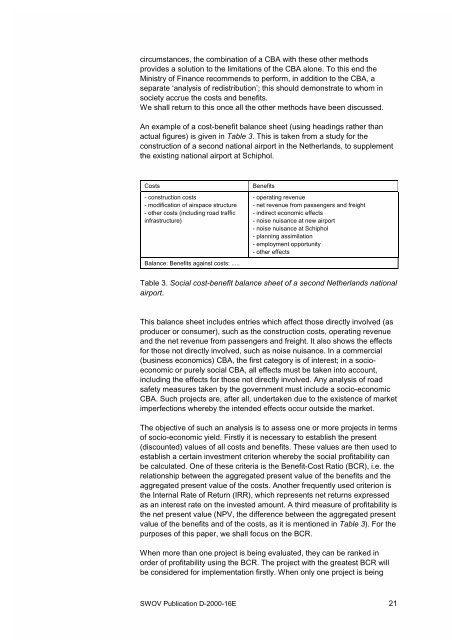Economic evaluation of road safety measures - Swov
Economic evaluation of road safety measures - Swov
Economic evaluation of road safety measures - Swov
You also want an ePaper? Increase the reach of your titles
YUMPU automatically turns print PDFs into web optimized ePapers that Google loves.
circumstances, the combination <strong>of</strong> a CBA with these other methods<br />
provides a solution to the limitations <strong>of</strong> the CBA alone. To this end the<br />
Ministry <strong>of</strong> Finance recommends to perform, in addition to the CBA, a<br />
separate ‘analysis <strong>of</strong> redistribution’; this should demonstrate to whom in<br />
society accrue the costs and benefits.<br />
We shall return to this once all the other methods have been discussed.<br />
An example <strong>of</strong> a cost-benefit balance sheet (using headings rather than<br />
actual figures) is given in Table 3. This is taken from a study for the<br />
construction <strong>of</strong> a second national airport in the Netherlands, to supplement<br />
the existing national airport at Schiphol.<br />
Costs<br />
- construction costs<br />
- modification <strong>of</strong> airspace structure<br />
- other costs (including <strong>road</strong> traffic<br />
infrastructure)<br />
Balance: Benefits against costs: .....<br />
Benefits<br />
- operating revenue<br />
- net revenue from passengers and freight<br />
- indirect economic effects<br />
- noise nuisance at new airport<br />
- noise nuisance at Schiphol<br />
- planning assimilation<br />
- employment opportunity<br />
- other effects<br />
Table 3. Social cost-benefit balance sheet <strong>of</strong> a second Netherlands national<br />
airport.<br />
This balance sheet includes entries which affect those directly involved (as<br />
producer or consumer), such as the construction costs, operating revenue<br />
and the net revenue from passengers and freight. It also shows the effects<br />
for those not directly involved, such as noise nuisance. In a commercial<br />
(business economics) CBA, the first category is <strong>of</strong> interest; in a socioeconomic<br />
or purely social CBA, all effects must be taken into account,<br />
including the effects for those not directly involved. Any analysis <strong>of</strong> <strong>road</strong><br />
<strong>safety</strong> <strong>measures</strong> taken by the government must include a socio-economic<br />
CBA. Such projects are, after all, undertaken due to the existence <strong>of</strong> market<br />
imperfections whereby the intended effects occur outside the market.<br />
The objective <strong>of</strong> such an analysis is to assess one or more projects in terms<br />
<strong>of</strong> socio-economic yield. Firstly it is necessary to establish the present<br />
(discounted) values <strong>of</strong> all costs and benefits. These values are then used to<br />
establish a certain investment criterion whereby the social pr<strong>of</strong>itability can<br />
be calculated. One <strong>of</strong> these criteria is the Benefit-Cost Ratio (BCR), i.e. the<br />
relationship between the aggregated present value <strong>of</strong> the benefits and the<br />
aggregated present value <strong>of</strong> the costs. Another frequently used criterion is<br />
the Internal Rate <strong>of</strong> Return (IRR), which represents net returns expressed<br />
as an interest rate on the invested amount. A third measure <strong>of</strong> pr<strong>of</strong>itability is<br />
the net present value (NPV, the difference between the aggregated present<br />
value <strong>of</strong> the benefits and <strong>of</strong> the costs, as it is mentioned in Table 3). For the<br />
purposes <strong>of</strong> this paper, we shall focus on the BCR.<br />
When more than one project is being evaluated, they can be ranked in<br />
order <strong>of</strong> pr<strong>of</strong>itability using the BCR. The project with the greatest BCR will<br />
be considered for implementation firstly. When only one project is being<br />
SWOV Publication D-2000-16E 21
















